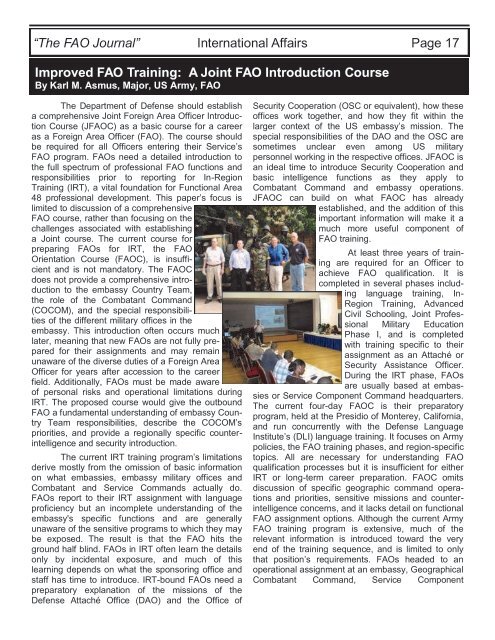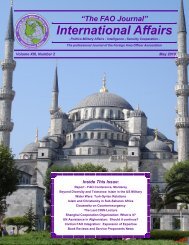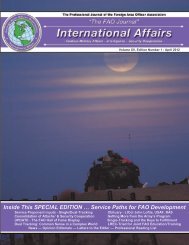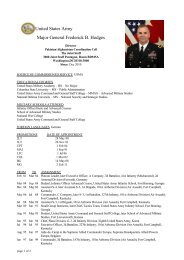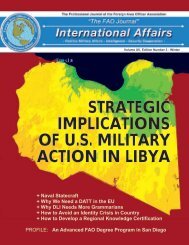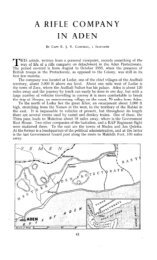FAO HISTORY Will the original FAO please stand up? - Faoa
FAO HISTORY Will the original FAO please stand up? - Faoa
FAO HISTORY Will the original FAO please stand up? - Faoa
- No tags were found...
Create successful ePaper yourself
Turn your PDF publications into a flip-book with our unique Google optimized e-Paper software.
“The <strong>FAO</strong> Journal” International Affairs Page 17Improved <strong>FAO</strong> Training: A Joint <strong>FAO</strong> Introduction CourseBy Karl M. Asmus, Major, US Army, <strong>FAO</strong>The Department of Defense should establisha comprehensive Joint Foreign Area Officer IntroductionCourse (J<strong>FAO</strong>C) as a basic course for a careeras a Foreign Area Officer (<strong>FAO</strong>). The course shouldbe required for all Officers entering <strong>the</strong>ir Service‘s<strong>FAO</strong> program. <strong>FAO</strong>s need a detailed introduction to<strong>the</strong> full spectrum of professional <strong>FAO</strong> functions andresponsibilities prior to reporting for In-RegionTraining (IRT), a vital foundation for Functional Area48 professional development. This paper‘s focus islimited to discussion of a comprehensive<strong>FAO</strong> course, ra<strong>the</strong>r than focusing on <strong>the</strong>challenges associated with establishinga Joint course. The current course forpreparing <strong>FAO</strong>s for IRT, <strong>the</strong> <strong>FAO</strong>Orientation Course (<strong>FAO</strong>C), is insufficientand is not mandatory. The <strong>FAO</strong>Cdoes not provide a comprehensive introductionto <strong>the</strong> embassy Country Team,<strong>the</strong> role of <strong>the</strong> Combatant Command(COCOM), and <strong>the</strong> special responsibilitiesof <strong>the</strong> different military offices in <strong>the</strong>embassy. This introduction often occurs muchlater, meaning that new <strong>FAO</strong>s are not fully preparedfor <strong>the</strong>ir assignments and may remainunaware of <strong>the</strong> diverse duties of a Foreign AreaOfficer for years after accession to <strong>the</strong> careerfield. Additionally, <strong>FAO</strong>s must be made awareof personal risks and operational limitations duringIRT. The proposed course would give <strong>the</strong> outbound<strong>FAO</strong> a fundamental under<strong>stand</strong>ing of embassy CountryTeam responsibilities, describe <strong>the</strong> COCOM‘spriorities, and provide a regionally specific counterintelligenceand security introduction.The current IRT training program‘s limitationsderive mostly from <strong>the</strong> omission of basic informationon what embassies, embassy military offices andCombatant and Service Commands actually do.<strong>FAO</strong>s report to <strong>the</strong>ir IRT assignment with languageproficiency but an incomplete under<strong>stand</strong>ing of <strong>the</strong>embassy's specific functions and are generallyunaware of <strong>the</strong> sensitive programs to which <strong>the</strong>y maybe exposed. The result is that <strong>the</strong> <strong>FAO</strong> hits <strong>the</strong>ground half blind. <strong>FAO</strong>s in IRT often learn <strong>the</strong> detailsonly by incidental exposure, and much of thislearning depends on what <strong>the</strong> sponsoring office andstaff has time to introduce. IRT-bound <strong>FAO</strong>s need apreparatory explanation of <strong>the</strong> missions of <strong>the</strong>Defense Attaché Office (DAO) and <strong>the</strong> Office ofSecurity Cooperation (OSC or equivalent), how <strong>the</strong>seoffices work toge<strong>the</strong>r, and how <strong>the</strong>y fit within <strong>the</strong>larger context of <strong>the</strong> US embassy‘s mission. Thespecial responsibilities of <strong>the</strong> DAO and <strong>the</strong> OSC aresometimes unclear even among US militarypersonnel working in <strong>the</strong> respective offices. J<strong>FAO</strong>C isan ideal time to introduce Security Cooperation andbasic intelligence functions as <strong>the</strong>y apply toCombatant Command and embassy operations.J<strong>FAO</strong>C can build on what <strong>FAO</strong>C has alreadyestablished, and <strong>the</strong> addition of thisimportant information will make it amuch more useful component of<strong>FAO</strong> training.At least three years of trainingare required for an Officer toachieve <strong>FAO</strong> qualification. It iscompleted in several phases includinglanguage training, In-Region Training, AdvancedCivil Schooling, Joint ProfessionalMilitary EducationPhase I, and is completedwith training specific to <strong>the</strong>irassignment as an Attaché orSecurity Assistance Officer.During <strong>the</strong> IRT phase, <strong>FAO</strong>sare usually based at embassiesor Service Component Command headquarters.The current four-day <strong>FAO</strong>C is <strong>the</strong>ir preparatoryprogram, held at <strong>the</strong> Presidio of Monterey, California,and run concurrently with <strong>the</strong> Defense LanguageInstitute‘s (DLI) language training. It focuses on Armypolicies, <strong>the</strong> <strong>FAO</strong> training phases, and region-specifictopics. All are necessary for under<strong>stand</strong>ing <strong>FAO</strong>qualification processes but it is insufficient for ei<strong>the</strong>rIRT or long-term career preparation. <strong>FAO</strong>C omitsdiscussion of specific geographic command operationsand priorities, sensitive missions and counterintelligenceconcerns, and it lacks detail on functional<strong>FAO</strong> assignment options. Although <strong>the</strong> current Army<strong>FAO</strong> training program is extensive, much of <strong>the</strong>relevant information is introduced toward <strong>the</strong> veryend of <strong>the</strong> training sequence, and is limited to onlythat position‘s requirements. <strong>FAO</strong>s headed to anoperational assignment at an embassy, GeographicalCombatant Command, Service Component


